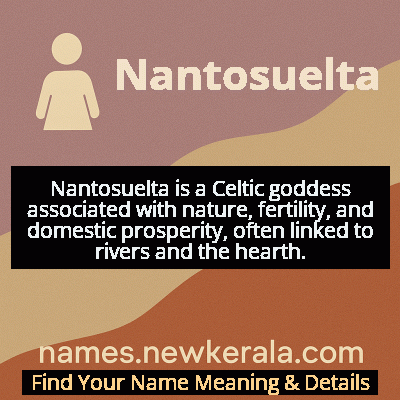Nantosuelta Name Meaning & Details
Origin, Popularity, Numerology Analysis & Name Meaning of Nantosuelta
Discover the origin, meaning, and cultural significance of the name NANTOSUELTA. Delve into its historical roots and explore the lasting impact it has had on communities and traditions.
Name
Nantosuelta
Gender
Female
Origin
Celtic
Lucky Number
7
Meaning of the Name - Nantosuelta
Nantosuelta is a Celtic goddess associated with nature, fertility, and domestic prosperity, often linked to rivers and the hearth.
Nantosuelta - Complete Numerology Analysis
Your Numerology Number
Based on Pythagorean Numerology System
Ruling Planet
Neptune (Ketu)
Positive Nature
Intuitive, analytical, spiritual, and inquisitive.
Negative Traits
Secretive, reserved, aloof, and can be overly critical.
Lucky Colours
Green, yellow.
Lucky Days
Monday.
Lucky Stones
Cat’s eye, moonstone.
Harmony Numbers
1, 5, 6.
Best Suited Professions
Scientists, researchers, spiritual leaders, detectives.
What People Like About You
Depth of knowledge, analytical skills, spirituality.
Famous People Named Nantosuelta
Nantosuelta of the Treveri
Celtic Goddess
Primary deity worshipped by the Treveri tribe in Gaul, often depicted with a cornucopia and beehive symbolizing abundance and domestic harmony
Nantosuelta the Healer
Mythological Figure
Legendary figure associated with healing springs and protective magic, particularly for women and children
Nantosuelta the Hearth-Keeper
Cultural Icon
Symbol of household prosperity and agricultural fertility, often invoked during seasonal festivals and harvest celebrations
Name Variations & International Equivalents
Click on blue names to explore their detailed meanings. Gray names with will be available soon.
Cultural & Historical Significance
During the Roman occupation of Gaul, Nantosuelta's worship continued and even syncretized with Roman deities, demonstrating her enduring cultural importance. She was sometimes equated with Roman goddesses like Fortuna or Ceres, but maintained her distinct Celtic characteristics. The locations of her shrines near rivers and fertile valleys suggest she was particularly venerated by agricultural communities who depended on her blessings for successful harvests and family wellbeing. Her imagery appears on numerous altars and votive offerings, indicating she was accessible to common people rather than just the elite, serving as a protector of everyday life and domestic harmony.
Extended Personality Analysis
Individuals named Nantosuelta are often perceived as nurturing, grounded, and deeply connected to nature and home life. They typically exhibit strong protective instincts toward family and community, embodying the goddess's role as a guardian of domestic harmony. These individuals tend to be practical yet creative problem-solvers who value stability and tradition while maintaining a warm, welcoming presence that makes others feel cared for and secure. Their strength lies in creating environments where people and projects can flourish, much like the fertile valleys associated with their namesake.
Nantosueltas often possess an intuitive understanding of natural cycles and rhythms, making them excellent at planning and organization. They're frequently drawn to activities involving gardening, cooking, crafts, or community building – anything that creates abundance and connection. While they may appear quiet or reserved initially, they reveal deep wisdom and resilience when faced with challenges. Their personality combines the steadfast reliability of the earth with the flowing adaptability of water, making them both anchors and nurturers in their social circles. They tend to be excellent mediators who can soothe tensions and help others find common ground.
Modern Usage & Popularity
In contemporary times, Nantosuelta remains an extremely rare given name, primarily used within pagan, Celtic revival, and historical reenactment communities. Its usage has seen a slight increase among parents seeking unique mythological names with deep cultural roots, particularly those interested in Celtic heritage or nature-based spirituality. The name appears occasionally in fantasy literature and gaming communities where Celtic mythology inspires character creation. While it hasn't entered mainstream baby name lists, its distinctive sound and rich mythological background make it appealing to those looking for names that are both unusual and meaningful. Modern bearers often choose the name for its connection to nature, femininity, and ancient European traditions. The name's rarity ensures it stands out while carrying centuries of cultural significance.
Symbolic & Spiritual Meanings
Nantosuelta symbolizes the interconnectedness of domestic life and natural abundance. Her imagery represents the Celtic understanding of prosperity as flowing from harmonious relationships between humans, land, and community. The cornucopia she carries signifies not just material wealth but the fullness of life – health, family, and spiritual wellbeing. The beehive symbolizes organized community effort and the sweet rewards of collective work, while her association with rivers represents the flow of life and nourishment. Together, these symbols create a powerful metaphor for sustainable living and the sacredness of everyday existence. She embodies the idea that true prosperity comes from caring for both home and habitat, making her an increasingly relevant figure in modern discussions about ecology and community values. Her symbolism extends beyond literal abundance to represent the fertility of ideas, relationships, and creative endeavors.

